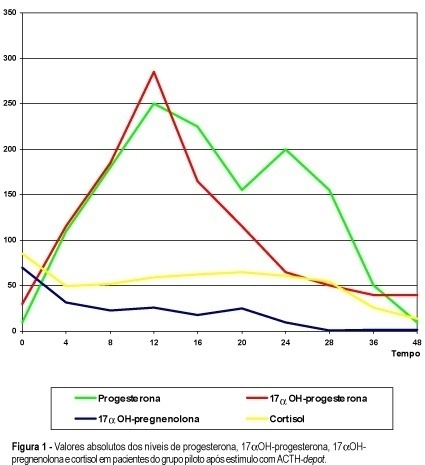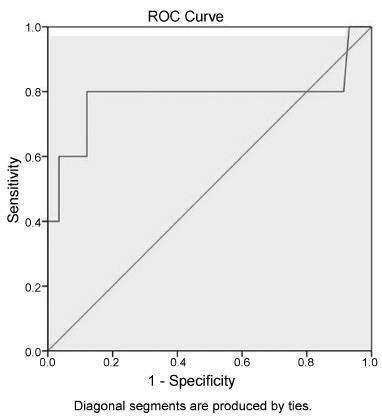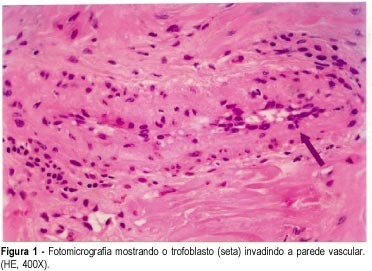Summary
Revista Brasileira de Ginecologia e Obstetrícia. 2004;26(7):585-585
Summary
Revista Brasileira de Ginecologia e Obstetrícia. 2000;22(9):585-591
DOI 10.1590/S0100-72032000000900008
Purpose: to test the adrenal function by a potent stimulus to its reticular layer verifying 3beta-hydroxysteroid dehy-drogenase (3beta-HSD) and 21-hydroxylase (21OH) enzymatic activities. Methods: plasma concentrations of 17alphaOH-pregneno-lone, 17alphaOH-progesterone, cortisol, progesterone, androstenedione, dehydroepiandrosterone (DHEA), dehydroepiandrosterone sulfate (SDHEA) and free testosterone were determined in 39 women, 13 of whom were normal (2 of them used in a pilot study) and 26 had idiopathic hirsutism, 0, 12 and 24 h after injection of ACTH-depot. Results: among hirsute women, we identified different responses that could diagnose any blockage in the steroid pathways leading to the diagnosis of a mild/moderate decreased adrenal function. The 17alphaOH-pregnenolone concentrations varied from 2.0 to 24.6 ng/mL, cortisol values increased from 2.1 to 45.3 and 38.4 mug/dL, 17alphaOH-progesterone levels varied from 50.7 to 346 and 218 ng/mL and progesterone increased from 0.3 to 4.4 and 2.2 ng/mL. Among the reticular layer hormones a rise of SDHEA from 274.7 to 495.5 and 505.8 mg/dL, and of androsterone from 1.1 to 4.0 and 4.5 ng/mL was observed, the levels of free testosterone increased from 1.3 to 1.8 and 2.7 pg/mL and the DHEA levels from 2.4 to 4.7 and 8.5 ng/mL. One patient showed 3beta-HSD deficiency and two others a possible 21OH deficiency. Conclusions: these findings suggest that the ACTH-depot test could be used to exclude the adrenal gland as the possible source of hyperandrogenism in women with idiopathic hirsutism.

Summary
Revista Brasileira de Ginecologia e Obstetrícia. 2017;39(11):585-586
Summary
Revista Brasileira de Ginecologia e Obstetrícia. 2016;38(12):585-588
Analyzing if the sonographic evaluation of the cervix (cervical shortening) is a prognostic marker for vaginal delivery.
Women who underwent labor induction by using dinoprostone were enrolled. Before the induction and three hours after it, the cervical length was measured by ultrasonography to obtain the cervical shortening. The cervical shortening was introduced in logistic regression models among independent variables and for calculating receiver operating characteristic (ROC) curves.
Each centimeter in the cervical shortening increases the odds of vaginal delivery in 24.4% within 6 hours; in 16.1% within 24 hours; and in 10.5% within 48 hours. The best predictions for vaginal delivery are achieved for births within 6 and 24 hours, while the cervical shortening poorly predicts vaginal delivery within 48 hours.
The greater the cervical shortening 3 hours after labor induction, the higher the likelihood of vaginal delivery within 6, 24 and 48 hours.

Summary
Revista Brasileira de Ginecologia e Obstetrícia. 2015;37(12):585-592
DOI 10.1590/S0100-720320150005481
To assess attitudes about eating, weight gain and body image of pregnant adolescents.
Pregnant adolescents (n=67) were assessed using the Body Image Questionnaire, the Attitude towards Weight Gain during Pregnancy scale (AWGP) and questions about risk behaviors for eating disorders and unhealthy weight control practices. Associations between variables were analyzed by ANOVA, Kruskal-Wallis test, Pearson and Spearman tests. The influence of the independent variables regarding skipping meals, body satisfaction and binge eating was evaluated by logistic regression.
The average age of the adolescents was 15.3 years (SD=1.14) and their average gestational age was 21.9 weeks (SD=6.53). The average AWGP score was 52.6 points, indicating a positive attitude towards weight gain, and 82.1% of the pregnant girls were satisfied with their bodies. Obese girls had more body dissatisfaction (p=0.001), and overweight girls thought more about food (p=0.02) and eating (p=0.03). The frequency of reported binge eating was 41.8%, and the frequency of skipping meals was 19%. Regression analysis showed that the current Body Mass Index (p=0.03; OR=1.18) and the importance of body awareness and fitness before pregnancy (p=0.03; OR=4.63) were predictors of skipping meals. Higher socioeconomic level (p=0.04; OR=0.55) and greater concern with weight gain (p=0.03; OR=0.32) predicted binge eating.
Even though the majority of the pregnant adolescents had positive attitudes toward weight gain and body satisfaction, those heavier and more concerned with weight gain had a higher risk of unhealthy attitudes, while those of lower social class, less concerned with weight gain and less embarrassed about their bodies during pregnancy, had a lower risk of unhealthy attitudes.
Summary
Revista Brasileira de Ginecologia e Obstetrícia. 2021;43(8):585-587
Summary
Revista Brasileira de Ginecologia e Obstetrícia. 2003;25(8):585-591
DOI 10.1590/S0100-72032003000800007
PURPOSE: to analyze the histopathological patterns of the placental bed arteries in pregnancies complicated by abruptio placentae (AP) and compare them with the normal vascular histology of the placental bed. METHODS: placental bed biopsy was performed in 23 pregnant women with a diagnosis of abruptio placentae associated with high blood pressure (G/HBP) disorders, with gestational age of 28 weeks or more, submitted to cesarean section. The control group (CG) consisted of 30 patients without disease, submitted to cesarean section for obstetric reasons. The selected histological variables were: unaltered pattern, physiological changes, medial layer disorganization, hyperplastic changes, acute necrosis and atherosis. RESULTS: in patients with AP associated with HBP there was a significant predominance of medial layer disorganization and hyperplastic changes, compared to CG, while physiological changes in spiral arteries were statistically more common in CG. Findings of acute necrosis and atherosis were observed in a low number of G/HBP, with no statistical significance. CONCLUSIONS: in pregnant women with AP associated with HBP the predominant vascular histological findings were medial layer disorganization and hyperplastic changes. The presence of histopathological features was significantly higher in G/HBP, with prevalence of medial layer disorganization. Normal histological pattern, i.e., physiological changes, were more prevalent in CG.

Summary
Revista Brasileira de Ginecologia e Obstetrícia. 2002;24(9):585-591
DOI 10.1590/S0100-72032002000900004
Purpose: to report 15 breast cancer cases associated with pregnancy and to compare to a control group with breast ductal infiltrating carcinoma, evaluating clinical staging, metastatic axillary lymph node involvement, histopathologic aspects related to nuclear grade, histology grade and estrogen and progesterone hormonal receptors. Method: a retrospective study of 15 cases of patients with breast cancer associated with pregnancy, attended at Mastology Department in the Woman Health Reference Center, Pérola Byington Hospital, São Paulo, was done between September 1996 and April 2001. The evaluation of clinical staging, time of diagnosis and involved axillary lymph nodes was the main study basis. Also age, parity, histologic type, applied treatment, histologic characteristics regarding nuclear grade and histologic grade and the presence of hormonal receptors in the tumors were analyzed. Results: we observed that 7 patients (46.7%) presented a locally advanced breast cancer (clinical stage IIIA and IIIB) and that 3 patients (20%) presented a disseminated disease at the moment of diagnosis. The patients presented on average 2.4 involved axillary lymph nodes and in only one patient the lymph nodes were free of disease (6.6%). Regarding time of diagnosis, 40% of the tumors were diagnosed during the lactational period, 46.7% during the second trimester and 13.3% during the third trimester. The pregnant patients were compared to a control group of non-pregnant patients in the same age range, all of them with infiltrating breast carcinoma, and clinical staging, axillary lymph node involvement, nuclear grade, histologic grade and estrogen and progesterone hormonal receptors were evaluated. There was a statistically significant difference (p=0.0022) regarding clinical staging and axillary lymph node involvement (p=0.0017), and no statistically significant difference as concerns the remaining parameters. Conclusion: breast cancer associated with pregnancy is a neoplasia with a bad prognosis. There is no difference when comparing pregnant patients with non-pregnant patients in the same age range, the advanced clinical staging at the moment of diagnosis being the determinant factor for survival.